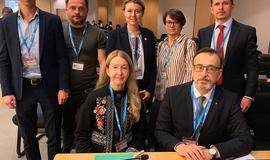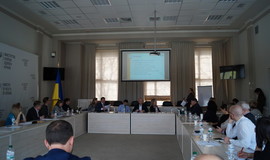News
How the healthcare system has changed
More than half of Ukrainians have chosen their doctor, and 76% of them are satisfied with service quality. More patients have access to high-quality medicines, and absolutely everyone has access to effective vaccines according to the immunization schedule. Health professionals have been able to earn more money, and the chances of bribe-takers are now much reduced. At that, requirements for admission to medical profession have increased.
76.6% OF UKRAINIANS ARE SATISFIED WITH THEIR FAMILY PHYSICIAN, THERAPIST OR PEDIATRICIAN
This is evidenced from the Rating Sociological Group survey conducted in October 2018. To date, more than 26 million Ukrainians – more than half of the citizens – have signed declarations with family physicians, therapists or pediatricians. This figure is considerably higher than that of in Ukrainian and foreign experts’ initial expectations, and witnesses to a powerful demand for change that exists in the society.
Last year, Ukrainian patients and health professionals received an explicit list of primary care services, which is free for every patient. A family physician, a therapist or a pediatrician diagnoses a disease, prescribes treatment and writes prescriptions, for which medicines available under the Available Medicines Program can be obtained, prescribes sick-leave certificates, issues certificates. Also, primary care physicians have at their disposal 8 basic laboratory and instrumental tests.
In 2019, the guaranteed service package will remain unchanged. In addition, from the second half of 2019 the Free Diagnostics Program will be launched. By referral from your family physician, you will be able to undergo several types of X-ray examinations, ultrasound examination, mammography, cardiac echocardiography, tests and other diagnostic tests in any health care facility of your choice participating in the program. The National Health Service of Ukraine (NHSU) shall pay for services under the program.
SIGNIFICANTLY HIGHER SALARIES OF HEALTH PROFESSIONALS IN HEALTH CARE FACILITIES INVOLVED IN THE TRANSFORMATION
Health care facilities that have already concluded contracts with NHSU began to receive payments based on the Money Follows the Patient (MFTP) principle. Effective municipal primary health care facilities received twice as much payments from NHSU than under the old funding model. In January alone, NHSU paid UAH 1.35 billion to health care facilities for primary care services provided to patients.
Changes in funding mainly affected health professionals’ salaries. The salary level is determined according to the collective agreement. Provided that priorities are properly set by the chief of the facility, physicians and nurses receive high salaries. For instance, in December physicians of Khmelnytskyi Primary Care Center No. 1 received about UAH 25 thousand, UAH 30 thousand at most as their salary subject to 1800 signed declarations for a family physician and 900 ones for a pediatrician. And in all Vinnytsia primary health care centers physicians are paid salaries worth UAH 25-29 thousand.
In Nova Kakhovka PHCC, Kherson Oblast, physicians’ salaries are UAH 15-16 thousand, and salaries for nurses have increased to UAH 10 thousand.
UKRAINIANS PAY BRIBES TO HEALTH WORKERS TWICE LESS
Ukrainians pay bribes rarely: in October 2018, 7% ‘rewarded’ their physician's pocket as compared with 15% four months earlier in June, and 20% in August 2017. Similarly, the culture to thank for services by giving gifts is winding down:27% of respondents ‘thanked’ physicians and nurses by giving gifts in June versus 14% in October.
This is evidenced from the sociological survey conducted by the Rating Sociological Group in October 2018.
Any coercive fundraising is unacceptable phenomenon in health care facilities. Equally, charitable contributions cannot be mandatory payments. In addition, the website of each oblast department should post compulsory information on the availability and cost of medicines and medical products acquired with funds of the State Budget of Ukraine, local budgets and other sources in health care facilities in Ukraine. That is, every Ukrainian can check whether there is the necessary medicine provided at no cost to patients in the health care facility and to see the cost at which specific medicines were purchased. It can be easily done online, even without leaving home. Regional departments should also monitor residual medicines and vaccines in each health care facility in the oblast and, if necessary, promptly redistribute them between the facilities.
An electronic residual medicines management system will be developed. This platform will enable to establish the process of monitoring residual medicines in hospitals and make information about medicines completely open and actually accessible to patients.
The Ministry of Health of Ukraine continues to fight corruption systematically in health care. Our goal is to create a new ecosystem in which the very causes of corruption will be impossible due to understandable, transparent, clear and honest new rules and procedures that are the same on all.
ABSOLUTELY ALL VACCINES BY THE NATIONAL IMMUNIZATION SCHEDULE ARE AVAILABLE
Vaccines by the National Immunization Schedule are the only reliable protection against 10 infectious diseases: hepatitis B, tuberculosis, measles, mumps, rubella, diphtheria, tetanus, pertussis, poliomyelitis and HIB infections. Vaccines are qualitative and effective, and have WHO prequalification, which is a quality assurance of the most authoritative organization in the area of health globally.
Vaccines for Ukraine financed from the State Budget are procured by the United Nations Children's Fund (UNICEF).
You can get vaccinated by vaccines procured at public expense ONLY in communal health care facilities (often referred to as ‘state’) health care facilities providing primary care. These are health care facilities where family doctors, therapists and pediatricians work. You should not look for vaccines purchased at public expense in private clinics or pharmacies. If you have signed a declaration with a family doctor, a therapist or a pediatrician from a private clinic or a physician as an individual entrepreneur, you can undergo a vaccination at any communal health care facility (‘state’ outpatient clinic).
If your health care facility does not have a vaccine, contact the chief physician of the health care facility to find out the cause. If the chief physician cannot provide the necessary information, contact the Department of Health in your oblast. It is the oblast departments that are responsible that each vaccination office in the oblast has available vaccines against all diseases on a schedule basis.
THE STATE BUYS SEVERAL TIMES MORE MEDICINES FOR COSTLY TREATMENT OF SERIOUS DISEASES
Efficiency of public procurement contributed to significant expansion of a number of positions that the state purchases for the treatment of cancer patients through international organizations over the past four years. This means that even more Ukrainians received expensive medicines for free. According to the Anti-Corruption Action Center (AntAC) report, the number of positions in the list of medicines procured by the state through international organizations for children and adults with cancer has increased by 30-40%, depending on the program. This has been achieved primarily due to increased competition, direct purchases from producers, building trust in procuring entities and procurement from foreign and Ukrainian suppliers, entry into the market of generic producers, and signing of long-term contracts with producers whose positions are monopolistic on the market.
The oncology program has generally been one of the most successful examples where the availability of medicines has increased significantly. Today, 90% of adult oncology medicines are less expensive than in 2014. Thus, for instance, the price for Bikalutamide was reduced 19 times, for Docetaxel 6 times, and for Gemtsitabin 4 times. In 2017, procurement of Nilotinib increased 6 times compared to that of by the Ministry of Health in 2014. Also, UNDP managed to buy Imatinib for patients with chronic myeloid leukemia 67 times cheaper than the Ministry did before purchasing through international organizations.
Last year, optimization of the processes allowed the Ministry of Health of Ukraine to double the funding of adult oncology: due to efficiency of public procurement through international organizations, another UAH 910 million were added to UAH 709 million provided for this area. Procurement for a total amount of about UAH 1.6 billion can provide a high percentage of coverage of pharmaceuticals requirements that are available in public procurement. This means that twice as many patients will receive medicines for cancer treatment free of charge. The state budget for 2019 provides for UAH 631 million for children's oncology, and UAH 1.3 billion for adult oncology.
2019 demonstrated another 10% increase in funding for adult oncology, hemophilia, multiple sclerosis, as well as a number of children's programs (cystic fibrosis, dwarfism, cerebral palsy, hepatitis, etc.), procurement of medicines for individuals with orphan diseases (Gaucher disease, pulmonary arterial hypertension, bullous epidermolysis, cystic fibrosis in adults). In addition, in 2019 funds for adults with juvenile rheumatoid arthritis (JRA) and primary immunodeficiency (PID) are planned for the first time since patients with these diagnoses after 18 years of age did not receive vital medicines from the state earlier.
Altogether, about 500 pharmaceuticals and over 700 medical products are procured under 40 areas of the state program.
PATIENTS WITH HEART FAILURE, CRITICAL STATUS OF BRONCHIAL ASTHMA AND TYPE 2 DIABETES MELLITUS CALLED AN AMBULANCE 17 THOUSAND TIMES LESS
Patients with these diseases (cardiovascular, type 2 diabetes mellitus and bronchial asthma) have been receiving medicines for a year or so for free or with a small fee under the Available Medicines Program. Currently, there are 258 pharmaceuticals (64 of which are free of charge), which can be exchanged for a physician's prescription in every third pharmacy in Ukraine (at the end of 2018 there were 7,501 pharmacies participating in the program).
In 2018, patients received 18 million prescription medicines worth more than UAH 1 billion, while with the program (from April 2017) they received over 32 million prescription medicines worth more than UAH 1.6 billion.
The government program prompts Ukrainians to visit doctors on a regular basis. This enables therapists to control the course of chronic diseases, to correct treatment in a timely manner and to prevent possible complications.
Regular intake of drugs and doctor’s visits significantly reduced the number of critical patient’s health condition. Thus, the survey in May last year showed that for the year of the Available Medicines Program operation, the number of patients with normalized blood sugar in type 2 diabetes mellitus increased by 6.5%. The number of emergency calls with a suspicion of a stroke or a heart attack decreased by 4.2%. There were almost 6% less ambulance calls from Ukrainians due to bronchial asthma attacks.
612 PATIENTS WITH ACUTE MYOCARDIAL INFARCTION WERE RESCUED IN THE NEW REPERFUSION CENTERS
Due to government program for the regional reperfusion centers development, 612 patients with acute myocardial infarction were rescued in 7 new reperfusion centers in 2018. And in such regions as Odesa, Vinnytsia, Ivano-Frankivsk, Cherkasy, the number of emergency stenting manipulations in acute heart attacks equaled the average in the EU countries, i.e. 300 per 1 million people.
Last year, for the first time in the history of independent Ukraine, the state met 100% requirement for stent systems for emergency care in patients with ST-segment elevation (patients with myocardial infarction who need immediate care).That is, every Ukrainian with acute myocardial infarction in a critical situation receives a free stent. Due to efficient procurement through international organizations, Ukraine buys 2.5-3 times more stents than in previous years. For instance, if earlier the stent costed Ukraine USD 280, then now it is USD 130, and the price for standard stents has decreased threefold and is about USD 70. This is the money the state pays for stents; for patients with life-threatening conditions who need care immediately (in acute myocardial infarction with ST segment elevation) stents are free.
A year earlier in 11 oblasts of Ukraine deaths from acute myocardial infarction decreased by 20% compared to 2015. These are oblasts where reperfusion centers are already operating.
The reperfusion center is a department in a health care facility where free coronary stenting is carried out (restoring blood flow through the artery to the heart) in acute myocardial infarction. In other words, it is a hospital where there is equipment for echocardiography, cardiology and intensive care departments with appropriate equipment, a laboratory for the determination of specific cardiological blood tests, and specialists with appropriate experience - interventional cardiologists. Such centers operate in 24/7/365 mode. There are currently 34 such centers in Ukraine. There are another 6 departments admitting patients with acute myocardial infarction, but they are not operational 24 hours a day. In 2019, additional 13 angiographs will be procured for 11 administrative territorial units.
IT WAS THE FIRST TIME THAT MEDICAL UNIVERSITIES SELECTED AMONG THE STRONGEST CANDIDATES TO UNIVERSITY ADMISSION
Last year, it was the first time that candidates to the specialties ‘Dentistry’, ‘Medicine’ and ‘Pediatrics’ were only those applicants who scored over 150 points based on the results of external independent evaluation of competitive subjects - biology, chemistry or mathematics. Setting a threshold allowed to select the best applicants. For instance, the average EIE of biology of last year's applicants to the contract specialty ‘Medicine’ was 170, and to ‘Dentistry’ - 177. Also, high motivation of freshmen has already been noted by medical university lecturers.
Establishing a threshold for entry into higher education institutions is part of the strategy for medical education development. This will improve the quality of health services, which depends on education of health professionals.
POWERFUL STRENGTHENING OF HEALTHCARE SYSTEM INSTITUTIONAL CAPACITY
In 2018, fundamentally new institutions were created, and activity of strategic institutions was significantly strengthened. Among the main achievements are:
- The National Health Service of Ukraine started operation. Beginning of 2019, 97% of health care facilities joined the transformation of the primary health care and concluded contracts with NHSU (about 20% of them are private institutions). These facilities have already switched to a new model of financing ‘Money Follows the Patient’, when the state pays for specific services provided to patients who have chosen their physician in this health care facility. Under the contract, NHSU paid to health care facilities UAH 3.5 billion in 2018, and UAH 1.35 billion in January 2019.
- SOE Electronic Health started operation as the developer of the technical core of the electronic health system in Ukraine. Launching of the electronic system allowed implementation of the Money Follows the Patient principle in terms of technical details: each declaration with selected physician is recorded in securely protected system, on the basis of which patients receive services from their physician, and the health care facility receives funds from NHSU for services provided to each patient. In 2019, due to new capacity of the electronic system, health care facilities will switch to the electronic documentation workflow: paper patient’s records, prescriptions, referrals, sick-leave certificates and certificates will gradually be replaced by electronic documents. This will simplify the processes of doctors' dealing with documents, and the state will receive transparency in conducting medical records and prevent the possibility of records being falsified.
- The national medical procurement agency, SOE Medical Procurement of Ukraine, was established, which will gradually take over procurement practices developed by international partners. The key tasks of SOE are to enhance efficiency of medical procurement at the national and regional levels, create a unified state center of competence in medical procurement. In 2018, SOE received an approved staffing table and recruited the first team members, began to build office infrastructure, the employee professionalization program, preparation of a pilot electronic catalogue for medical procurements in the ProZorro system. In January 2019, the Medical Procurement of Ukraine announced its first tenders. It is planned that from 2020, it will begin to function as a fully-fledged central purchasing organization and to procure for the state budget funds, including through framework agreements and electronic catalogues.
- Capacity of the Public Health Center (MoH), which is responsible for preservation and strengthening of Ukrainians’ health, in particular, disease prevention, fighting against epidemics, epidemiological surveillance, biological safety, strategic management in the field of public health, has been strengthened. Last year, due to high standard of the Center’s performance noted by WHO, Ukraine joined the Global Influenza Surveillance and Response Network. For the first time the national plan for control of non-communicable diseases was developed, the three-year planning for vaccine procurement was launched to ensure continuous availability of vaccines in all regions, people with TB and HIV were fully provided with the necessary treatment, and the standard for public health education was approved. During this year, the PHC system should form a network for centers to operate in each region of the country and to assist public health units locally.



